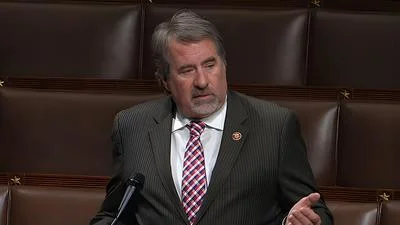With the U.S. House of Representatives’ Transportation Subcommittee on Railroads, Pipelines and Hazardous Materials set to convene on Tuesday – soon after the National Transportation Safety Board issued a report explaining that mechanical failures and communications technology issues both caused and exacerbated the severity of the East Palestine, Ohio train derailment last year – a main focus is on preventing a similar event from happening again.
The Subcommittee, which is a part of the larger Committee on Transportation and Infrastructure, will hold a hearing titled, “Examining the State of Rail Safety in the Aftermath of the Derailment in East Palestine, Ohio” at 2 p.m. Eastern Time on Tuesday, in Room 2167 of the Rayburn House Office Building, in Washington, D.C.
The Subcommittee has jurisdiction over the economic and safety regulation of railroads, the transportation of hazardous materials and the issue of pipeline safety – in addition to the agencies which administer those regulations – and is chaired by Rep. Troy Nehls (R-TX).
The Subcommittee also includes more than 30 members of the U.S. House of Representatives, including Reps. Brian Babin (R-TX); David Rouzer (R-NC); Mike Bost (R-IL); Doug LaMalfa (R-CA); Bruce Westerman (R-AR); Pete Stauber (R-MN); Tim Burchett (R-TN); Dusty Johnson (R-SD); Lance Gooden (R-TX); Tracey Mann (R-KS); Rudy Yakym (R-IN); Tom Kean, Jr. (R-NJ); Eric Burlison (R-MO); Brandon Williams (R-NY); Marc Molinaro (R-NY); John Duarte (R-CA); Sam Graves (R-MO); Frederica S. Wilson (D-FL); Seth Moulton (D-MA); Troy Carter (D-LA); André Carson (D-IN); Mark DeSaulnier (D-CA); Marilyn Strickland (D-WA); Valerie Foushee (D-NC); Grace F. Napolitano (D-CA); Steve Cohen (D-TN); Henry C. Johnson. Jr. (D-GA); Jared Huffman (D-CA); Jesús García (D-IL); Robert Menendez (D-NJ); Chris Deluzio (D-PA) and Rick Larsen (D-WA).
Federal Newswire reported in May that the American Association of Railroads (AAR) told the Federal Communications Commission (FCC) that its members would comply with a Sept. 2025 deadline to transition to new communications technology, enabling freight trains to finally access modern, high-bandwidth software applications that will improve safety.
In comments submitted to the FCC on May 2, the AAR wrote that its members planned to “complete the transition...by the Sept 14, 2025 deadline” and that they would invest $110 million in equipment to accommodate the new standards, which it would move the industry off “1980’s technology.”
Currently, freight rail operators in North America communicate using low-speed 900 MHz two-way radios, akin to dial-up internet. And their communications don’t conform to common “802.16” wireless broadband standards developed to secure private wireless networks in other industries.
“The railroads agreed to the 900 MHz transition plan and have already made a significant investment in rail safety innovation with the new wider narrowband channels…and new waveforms (like 802.16). AAR has already spent more than $2 million over the past two years on testing and working to adapt the new 802.16 standards to the unique operational requirements of the rail industry,” wrote AAR attorney Michele C. Farquhar in a brief to the FCC.
Farquhar said the AAR expected the transition, which started in 2020 and will require the replacement of approximately 9,500 radios, to “improve existing rail network capacity constraints across its narrowband spectrum assets and accommodate new safety applications.”
In May 2020, the FCC voted unanimously to transition the AAR’s existing 900 MHz band, used by the freight railroads for their legacy Advanced Train Control System (ATCS), so it could enable broadband.
Ondas Networks and Siemens Mobility have since partnered to develop and sell freight operators new wireless network technology and radios that meet the modern standards.
In Jan. 2023, the companies announced their first railroad order for radios in anticipation of the 2025 transition.
Inquiries made by Federal Newswire to Subcommittee members Rep. Nehls, Rep. Moulton, Rep. Graves and Rep. Kean on the status of the 2025 safety equipment transition plan, whether it would be discussed at the hearing and the steps that the Subcommittee planned to take to ensure it occurred on schedule, went unreturned.
Federal Newswire had specifically asked the members whether the railroads would be asked about their transition plan at the hearing, and what actions the Subcommittee would take to ensure the transition takes place to meet the deadline.
“NTSB investigators have spent over a year analyzing the derailment’s causes to inform recommendations aimed at preventing similar accidents. Railroads implemented substantial, industry-wide improvements in response to the NTSB’s initial findings. With the final report, railroads will carefully evaluate key learnings and determine next steps to meaningfully advance safety,” Michael Rush, Senior Vice President of AAR Safety and Operations, said.
The AAR added that “many of the NTSB findings align with positions the industry has long maintained, including the need to aggressively phase out DOT-111 tank cars from hazmat service and other tank car improvements.”
Following a June 25 hearing, the AAR said, “Railroads are reviewing the complete findings and recommendations to identify the potential need for additional research surrounding bearing performance or other joint industry efforts.”
According to the AAR, since the NTSB released its preliminary findings, railroads have applied lessons learned and taken significant steps that bolster safety and address what happened in the February 2023 incident – which included a multi-prong approach to enhance the effectiveness of wayside detectors and improve first responder preparedness and address tank car standards, in addition to the $23 billion that railroads invest annually in rail safety, employee training, infrastructure improvements and technological advancements.
North America has 136,667 miles of railroad track moving 1.6 billion tons of freight annually.
It is home to six “Class I” freight railroad companies – Fort Worth-based BNSF Railway, the Montreal-based Canadian National Railway, Calgary-based Canadian Pacific Kansas City, Jacksonville-Based CSX Transportation, Atlanta-based Norfolk Southern Railway and the Omaha-based Union Pacific Railroad. All are members of AAR.









